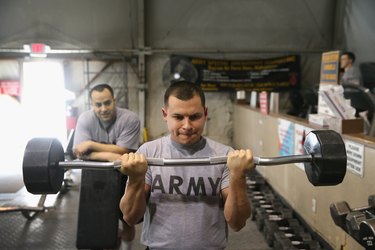
When a member of the United States Army weighs more than the Army's acceptable weight standards, a tape test is administered to determine body fat percentage. Occasionally, the test might also be given if a unit commander or supervisor feels that an individual's appearance suggests excessive body fat. According to the official Army Weight Control Program, members of the United States Army are "encouraged to achieve the more stringent Department of Defense goal, which is 18 percent body fat for males and 25 percent body fat for females." However, the Army's tape test body fat standards accept individuals with a wider range of body fat percentages.
Body Fat Standards
Video of the Day
As of September 2013, the United States Army has designated acceptable body fat measurements for military personnel based on age and gender. Male personnel age 17 to 20 are allowed a body fat percentage up to 20 percent, while female personnel in the same age group are allowed a body fat percentage up to 30 percent. In the age group of 21 to 27, males may have a body fat percentage up to 22 percent, while female's body fat percentage may be as high as 32 percent. In the 28 to 39 age group, the maximum allowable body fat percentage increases to 24 percent for males and 34 percent for males. The body fat standards increase slightly more for personnel age 40 and older, with a maximum percentage of 26 percent for males and 36 percent for females.
Video of the Day
Procedure
The military tape test uses a calibrated, non-stretch tape measure, preferably made of fiberglass. Cloth and steel tape measures are prohibited from use. The soldier should wear standard PT uniform of gym shorts, a t-shirt and socks. During the test, the solider stands in a straight position on a flat surface with the head erect and eyes pointed forward. For males, body circumference is measured around the neck and waist. For women, body circumference is measured around the neck, waist and hips. The tape should make contact with the skin and conform to the specific body part being measured. However, it should not compress the underlying body tissue. When measuring the hip circumference, slightly firmer pressure is applied with the tape to compress the gym shorts against the body.
Results
All measurements are recorded to the nearest half-inch. The entire set of measurements is taken three times and each sequential measurement must be within ½ inch of the previous measurement. If the measurements differ by more than ½ inch, additional measurements are taken until an appropriate set of three measurements is available. Then, an average is taken from these three measurements. To determine a male's "circumference value," the average neck circumference is subtracted from the average waist circumference. For a female's "circumference value," add the average waist and hip measurements together and then subtract the average neck measurement. The individual's circumference value and height in inches are then matched up in the Army's body fat percentage chart, as seen in the Army Weight Control Program.
Test Failure
Army personnel who fail to meet the body fat tape test standards will be provided with counseling and education sessions on maintaining proper weight and body fat. Overweight personnel may be ineligible for promotion and cannot be assigned to command, command sergeant major or first sergeant military positions. Additionally, overweight personnel are not allowed to attend professional military schools.